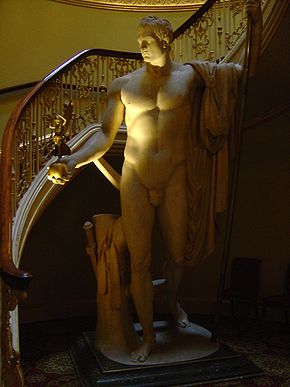- Napoleon as Mars the Peacemaker
-
Napoleon as Mars the Peacemaker Artist Antonio Canova Year 1802-1806 Type White marble Dimensions 345 cm (136 in) Location Apsley House, London Napoleon as Mars the Peacemaker is a colossal heroic nude statue by the Italian artist Antonio Canova, of Napoleon I of France in the guise of the Roman god Mars. He holds a gilded Nike or Victory standing on an orb in his right hand and a staff in his left. It was produced between 1802 and 1806 and stands 3.45 metres to the raised left hand. Once on display in the Louvre in Paris, it was purchased from Louis XVIII in 1816 by the British government, which granted it to the Duke of Wellington. It is now on display in Robert Adam's stairwell at the Duke's London residence, Apsley House.
Contents
History
At Napoleon's personal and insistent demand, Canova came to Paris in 1802 to model a bust of him, before returning to Rome to work on the full sculpture. Its idealised nude physique draws on the iconography of Augustus,[1] and it was always intended for an interior entrance-hall setting rather than as a freestanding piazza sculpture, though some accounts give the centre of the courtyard of the Palazzo del Senato as the original intended site for the sculpture, following plans drawn up by the architect Luigi Canonica. France's ambassador in Rome François Cacault and the director of French museums Vivant Denon both saw the sculpture while it was a work in progress: Cacault wrote in 1803 that it "must become the most perfect work of this century", whilst Denon wrote back to Napoleon in 1806 that it belonged indoors in the Musée Napoléon "among the emperors and in the niche where the Laocoon is, in such a manner that it would be the first object that one sees on entering". It was completed in 1806 and transported to the Musée Napoléon, but when Napoleon saw it there in April 1811 he refused to accept it, calling it "too athletic" and banning the public from seeing it. By that point his official iconography tended more towards that of hard-working law-giver, as in David's 1812 Napoleon in his cabinet de travail, rather than semi-divine hero.
By 1814 the sculpture was in the Salle des Hommes Illustres, hidden behind a canvas screen, where it was probably first seen by Wellington. In the era after the battle of Waterloo Canova, who was still regarded as the best living artist, with his works in great demand from English patrons in particular, supported the return of looted sculptures from the Musée Napoléon to their original collections. The Musée Napoléon reverted to being the Louvre and its looted sculptures such as the Apollo Belvedere were returned to their original collections, with the removal of the Napoleon was also mooted and Canova offering to re-purchase it. It was sold to the British government in 1816 for 66,000 francs (then under £3,000), which the Louvre spent on re-installing its Salle des Antiques. Works by Canova were already being collected by the Duke, and the Prince Regent presented it to him later that year. It was moved to the stairwell in Apsley House in 1817, where the floor under the statue was specially strengthened in order to accommodate the additional weight. It is still on display there.
Bronze in Milan
In 1811 a bronze copy of the statue was cast by the Righetti brothers. Since 1859 this copy has stood in the courtyard of the Palazzo dell'Accademia e della Pinacoteca di Brera.[2]
Notes
- ^ A comparable nude sculpture of another member of the Bonaparte family is Canova's Venus Victrix of Pauline Bonaparte.
- ^ On 25 October 1978, vandals removed the Victory from the globe.
External links
- 'How Canova and Wellington honoured Napoleon', by Julius Bryant, Apollo, October 2005
- Sewell, Brian (14 December 2007). "Seven wonders of London". Evening Standard. http://www.thisislondon.co.uk/arts/review-23427689-details/Seven+wonders+of+London/review.do?reviewId=23427689.
- Christopher M. S. Johns, 'Portrait Mythology: Antonio Canova's Portraits of the Bonapartes', Eighteenth-Century Studies, Vol. 28, No. 1 (Autumn, 1994), pp. 115-129 (available on JSTOR)
Categories:- Sculptures by Antonio Canova
- Sculptures of Napoleon
- 19th-century sculptures
Wikimedia Foundation. 2010.


